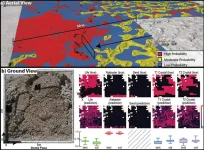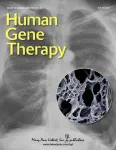(Press-News.org) The emergence of new COVID-19 variants has led to reduced accuracy across current rapid testing methods, but a recent University of Michigan study suggests that a patient’s breath might hold the key to a more precise diagnosis.
Investigators from the University of Michigan’s Max Harry Weil Institute for Critical Care Research and Innovation, including faculty and students from the College of Engineering and Michigan Medicine, used portable gas chromatography to examine breath samples collected during the pandemic’s Delta surge and its transition to Omicron (from April 2021 to May 2022.)
Their results, published February 28 in JAMA Network Open, showed that the GC technology could diagnose COVID-19 with a high level of accuracy. They also revealed that the volatile organic compounds contained in the breath of patients with Omicron differed from those in patients with Delta and earlier variants—molecular-level differences which, according to the team, could potentially be used to distinguish between COVID-19, its variants and non-COVID illnesses.
“Exhaled breath contains hundreds of VOCs, which the body produces in response to infection and inflammation,” said principal investigator and study author Xudong (Sherman) Fan, Ph.D., Richard A. Auhll Endowed Professor of Biomedical Engineering and associate director of the Weil Institute. “Early in the pandemic, we used GC technology to discover and define sets of VOCs for detecting COVID-19. However, we needed to gain a better understanding of how dynamically emerging variants impact this technology.”
Supported by a $2 million grant from the National Institutes of Health Rapid Acceleration of Diagnostics initiative’s Screening for COVID-19 by Electronic-Nose Technology program, the team conducted a diagnostic study of 167 adult patients in the Michigan Medicine ICUs and emergency department. They collected 205 breath samples from symptomatic and asymptomatic patients in 3 cohorts:
COVID-19 (2021): Patients with COVID-19 who were recruited before December 14, 2021 and were assumed to be infected by the Delta or earlier variants
COVID-19 (2022): Patients with COVID-19 who were recruited from January 2022 to the end of May 2022 and were assumed to be infected by the Omicron variant
Non-COVID-19 illness: Patients who were COVID-19 negative at the time of breath analysis, as well as patients who were previously COVID-19 positive but had recovered
Using a novel point-of-care GC device developed by Fan and the team, in combination with an advanced biomarker discovery algorithm and data analysis platform developed at the College of Engineering and the Weil Institute, the investigators defined four sets of VOCs that were able to distinguish between COVID-19 (2021) and non-COVID illness with a sensitivity of 92.7%, a specificity of 95.5% and an accuracy of 94.7%. However, when the team applied the same VOCs in a setting of presumed Omicron, sensitivity decreased drastically to 60.4%.
“We already knew clinically that different strains of SARS-CoV-2 can act quite differently,” said study co-author Robert Dickson, M.D., associate professor of Pulmonary and Critical Care Medicine and deputy director of the Weil Institute. “This decrease in performance supports our suspicion that their effects on lung biology are quite different as well.”
Based on their findings, the team hypothesized that it could be possible to use breath analysis to distinguish between COVID variants. They undertook additional biomarker searches and defined new VOCs to discern between Omicron and Delta, Omicron and non-COVID illness, and between patients with COVID-19 and non-COVID illness regardless of variants. The combined analysis resulted in the ability to detect COVID-19 infected patients (regardless of variant) from non-COVID patients with a sensitivity of 89.4%, a specificity of 91.0% and an accuracy of 90.2%. This performance is close to that of RT-PCR tests (the gold standard) and better than many rapid antigen tests.
Co-author and co-principal investigator Kevin Ward, M.D., professor of Emergency Medicine and Biomedical Engineering and executive director of the Weil Institute said, “This work suggests that breath analysis using point-of-care GC may be a promising method for detecting COVID-19 and similar diseases that result in VOC production. However, as we are seeing with other detection and testing methods, the emergence of viral variants continues to pose challenges.” The team notes that further analysis will be needed to determine how to overcome these challenges and use breath analysis to improve the diagnosis and care of patients.
“The fact that we were able to diagnose COVID-19 in both symptomatic and asymptomatic participants is encouraging,” said Fan. “More studies on these particular VOCs, including their origins, may assist in the development of a better understanding of COVID-19 as well as the potential to develop new diagnostics.”
“Looking ahead, our diagnostic approach to COVID-19 and the lung injury it causes will need to be as dynamic as the virus itself,” said Dickson.
The portable GC technology has now been licensed from the University of Michigan by the company Blu Biotech for its commercialization. The company is looking to develop the technology for the diagnosis and monitoring of not only COVID-19 but other diseases such as sepsis, acute respiratory distress syndrome, inflammatory bowel disease and others that produce VOCs due to inflammation.
---
Paper cited: “Portable Breath-Based Volatile Organic Compound Monitoring for the Detection of COVID-19 During the Circulation of the SARS-CoV-2 Delta Variant and the Transition to the SARS-CoV-2 Omicron Variant,” JAMA Network Open. DOI: 10.1001/jamanetworkopen.2023.0982
Study authors include Ruchi Sharma, PhD (Weil Institute, Biomedical Engineering); Wenzhe Zang, PhD (Weil Institute, Biomedical Engineering); Ali Tabartehfarahani, PhD (Weil Institute, Biomedical Engineering); Andres Lam, MSc (Weil Institute, Biomedical Engineering); Xiaheng Huang, MSc (Weil Institute, Biomedical Engineering, Electrical Engineering & Computer Science); Anjali Devi Sivakumar, BTech (Weil Institute, Biomedical Engineering, Electrical Engineering & Computer Science); Chandrakalavathi Thota, PhD (Weil Institute, Biomedical Engineering); Shuo Yang, PhD (Weil Institute, Biomedical Engineering); Robert Dickson, MD (Weil Institute, Pulmonary & Critical Care Medicine); Michael Sjoding, MD (Weil Institute, Pulmonary & Critical Care Medicine); Erin Bisco, BA (Weil Institute, Emergency Medicine); Carmen Colmenero Mahmood, BSc (Weil Institute, Emergency Medicine); Kristen Machado Diaz, BSc (Weil Institute, Emergency Medicine); Nicholas Sautter, BSc (Weil Institute, Electrical Engineering & Computer Science); Sardar Ansari, PhD (Weil Institute, Emergency Medicine); Kevin Ward, MD (Weil Institute, Emergency Medicine, Biomedical Engineering); Xudong Fan, PhD (Weil Institute, Biomedical Engineering)
Disclosures: The University of Michigan is a partial owner and Xudong Fan is an inventor of technology being used in this research project that is licensed to Nanova Environmental, Inc., a company in which Fan serves as an outside consultant unrelated to this project. Technology is also optioned to the Beijing Institute of Collaborative Innovation, a study sponsor.
Study researchers, Xudong Fan, Kevin Ward, Ruchi Sharma and Wenzhe Zang, are inventors of a technology being used in this project that is optioned to a company called BlueBiotech, Inc., which is partially owned byFan and Ward. The company was created to commercialize this technology. It is possible that the University of Michigan, Nanova Environmental, Inc., BICI, Blue Biotech, Inc., or the researchers may one day benefit financially from the results of the study.
Michael Sjoding and Sardar Ansari previously received grants from the NIH outside this project.
END
Study finds exhaled breath could enhance detection, diagnosis of COVID-19 and variants
Research suggests volatile organic compounds in breath could mark distinction between COVID-19, variants and non-COVID illnesses
2023-03-06
ELSE PRESS RELEASES FROM THIS DATE:
Some ‘allies’ don’t want gay neighbors
2023-03-06
In a survey of 545,531 people, 8.5% of those who said they were ‘fully accepting’ of gay people did not want gay neighbors.
First study to explore stigmatizing behaviors expressed by avid supporters of sexual minorities
‘Simple legal inclusion can help mobilize the accepting population to their fullest potential’
CHICAGO --- When legal systems choose to offer no protections to sexual minorities, even avid LGBTQ supporters would reject their gay neighbors, reports a new Northwestern Medicine study.
The study examined ...
An innovative twist on quantum bits: Tubular nanomaterial of carbon makes ideal home for spinning quantum bits
2023-03-06
Scientists find that a tubular nanomaterial of carbon makes for ideal host to keep quantum bits spinning in place for use in quantum information technologies.
Scientists are vigorously competing to transform the counterintuitive discoveries about the quantum realm from a century past into technologies of the future. The building block in these technologies is the quantum bit, or qubit. Several different kinds are under development, including ones that use defects within the symmetrical structures of diamond and silicon. They may one day transform computing, accelerate drug discovery, generate unhackable networks and more.
Working with researchers from several universities, scientists ...
LOINC continues facilitating health data interoperability with biannual issuance of new concepts
2023-03-06
INDIANAPOLIS -- LOINC® from Regenstrief Institute is issuing its semi-annual release, which contains 608 new concepts to help health systems, laboratories and other health organizations accurately exchange medical data. Some of the new information has been released in coordination with the U.S. Food and Drug Administration, the U.S. Centers for Disease Control and Prevention and the Association of Public Health Laboratories.
“Aligning the release of LOINC with emerging healthcare trends is an important component of our mission and critical in promoting effective health information exchange among providers, patients and health systems,” said Marjorie Rallins, ...
New study uncovers key culprit behind pediatric brain cancer metastasis
2023-03-06
New research pinpoints a key cause of metastasis from an aggressive form of brain cancer in children and provides a potential new therapy for treating these tumors in the future.
In a paper, published in Nature Cell Biology, physician-scientists from the University of Pittsburgh and UPMC Children’s Hospital of Pittsburgh discovered that medulloblastomas hijack a skill that normal brain cells use during their early development and then manipulate it to help tumors spread.
“Children with medulloblastomas that have not yet metastasized may have a high likelihood of long-term survival, but if ...
Can artificial intelligence help find life on Mars or icy worlds?
2023-03-06
March 6, 2023, Mountain View, CA – Wouldn’t finding life on other worlds be easier if we knew exactly where to look? Researchers have limited opportunities to collect samples on Mars or elsewhere or access remote sensing instruments when hunting for life beyond Earth. In a paper published in Nature Astronomy, an interdisciplinary study led by SETI Institute Senior Research Scientist Kim Warren-Rhodes, mapped the sparse life hidden away in salt domes, rocks and crystals at Salar de Pajonales at the boundary of the Chilean Atacama Desert and Altiplano. Then they trained a machine learning model to recognize the patterns and rules associated with their distributions ...
Geosciences at the Crossroads of America
2023-03-06
Boulder, Colo., USA: Oklahoma State University is hosting the 57th annual meeting of the Geological Society of America’s South-Central Section on 13–14 March. The meeting will have a diverse program of workshops, technical sessions, short courses, and field trips that covers a spectrum of geologic disciplines.
The list below highlights a selection of environmental-related session topics you might like:
· Tar Creek Superfund Site Field Trip (Field Trip)
Managed Aquifer Recharge in the Arbuckle Simpson Aquifer (Field Trip)
Geoscience Career Workshop: Career Planning and Networking
· Hydrogeologic Challenges and Roles ...
Gene and cell therapies to combat pancreatic cancer
2023-03-06
Pancreatic cancer is an incurable form of cancer, and gene therapies are currently in clinical testing to treat this deadly disease. A comprehensive review of the gene and cell biotherapies in development to combat pancreatic cancer is published in the peer-reviewed journal Human Gene Therapy. Click here to read the article now
The article titled “Pancreatic Cancer Cell and Gene Biotherapies: Past, Present and Future,” contributed by corresponding author Pierre Cordelier, from the University of Toulouse, and coauthors, ...
Oncotarget | HALP score: Prognostic ability in cancers - a literature review
2023-03-06
“In the last several years, the Hemoglobin, Albumin, Lymphocyte, Platelet Score (HALP) has emerged in the literature as a new prognostic biomarker [...]”
BUFFALO, NY- March 6, 2023 – A new review paper was published in Oncotarget's Volume 14 on February 25, 2023, entitled, “What is hemoglobin, albumin, lymphocyte, platelet (HALP) score? A comprehensive literature review of HALP’s prognostic ability in different cancer types.”
Since its inception, the Hemoglobin, Albumin, Lymphocyte, Platelet (HALP) Score has gained attention as a new prognostic biomarker to predict several clinical outcomes in a multitude ...
Nationwide study finds that women have greater risk of mortality than men after coronary artery bypass surgery
2023-03-06
Compared with men, women continue to have a roughly 30-40 percent higher risk of dying following coronary artery bypass surgery, according to a large study led by investigators at Weill Cornell Medicine and NewYork-Presbyterian/Weill Cornell Medical Center. The analysis showed that, without adjusting for differences in age and other health factors that influence risk, the female bypass patients had a 2.8 percent rate of death during or soon after surgery, compared with 1.7 percent for male patients, a nearly 50 percent difference that only dropped 10-20 percent after accounting for these factors.
The study, which appears Mar. 1 in JAMA Surgery, was based on ...
Assessing the risk of excess folic acid intake
2023-03-06
It is well established that folic acid supplementation can significantly reduce the risk of birth defects, including neural tube defects like spina bifida, the most common birth defect of the central nervous system and the second most common of all structural birth defects. More than 80 nations, including the U.S. 25 years ago, have established mandated folic acid food fortification programs, which have been successful.
“However, there is a lack of research on whether excessive folic acid intake has the potential ...
LAST 30 PRESS RELEASES:
University of Oklahoma researcher awarded funding to pursue AI-powered material design
Exploring how the visual system recovers following injury
Support for parents with infants at pediatric check-ups leads to better reading and math skills in elementary school
Kids’ behavioral health is a growing share of family health costs
Day & night: Cancer disrupts the brain’s natural rhythm
COVID-19 vaccination significantly reduces risk to pregnant women and baby
The role of vaccination in maternal and perinatal outcomes associated with COVID-19 in pregnancy
Mayo Clinic smartwatch system helps parents shorten and defuse children's severe tantrums early
Behavioral health spending spikes to 40% of all children’s health expenditures, nearly doubling in a decade
Digital cognitive behavioral treatment for generalized anxiety disorder
Expenditures for pediatric behavioral health care over time and estimated family financial burden
Air conditioning in nursing homes and mortality during extreme heat
The Alps to lose a record number of glaciers in the next decade
What makes a good proton conductor?
New science reporting guide published for journalists in Bulgaria
New international study reveals major survival gaps among children with cancer
New science reporting guide published for journalists in Turkey
Scientists develop a smarter mRNA therapy that knows which cells to target
Neuroanatomy-informed brain–machine hybrid intelligence for robust acoustic target detection
Eight SwRI hydrogen projects funded by ENERGYWERX
The Lundquist Institute and its start-up company Vitalex Biosciences Announces Strategic Advancement of Second-Generation fungal Vaccine VXV-01 through Phase 1 Trials under $40 Million Competitive Con
Fine particles in pollution are associated with early signs of autoimmune disease
Review article | Towards a Global Ground-Based Earth Observatory (GGBEO): Leveraging existing systems and networks
Penn and UMich create world’s smallest programmable, autonomous robots
Cleveland researchers launch first major study to address ‘hidden performance killer’ in athletes
To connect across politics, try saying what you oppose
Modulating key interaction prevents virus from entering cells
Project explores barriers to NHS career progression facing international medical graduates
Jeonbuk National University researchers explore the impact of different seasonings on the flavor perception of Doenjang soup
Two Keck Medicine of USC Hospitals named Leapfrog Top Teaching Hospitals
[Press-News.org] Study finds exhaled breath could enhance detection, diagnosis of COVID-19 and variantsResearch suggests volatile organic compounds in breath could mark distinction between COVID-19, variants and non-COVID illnesses




